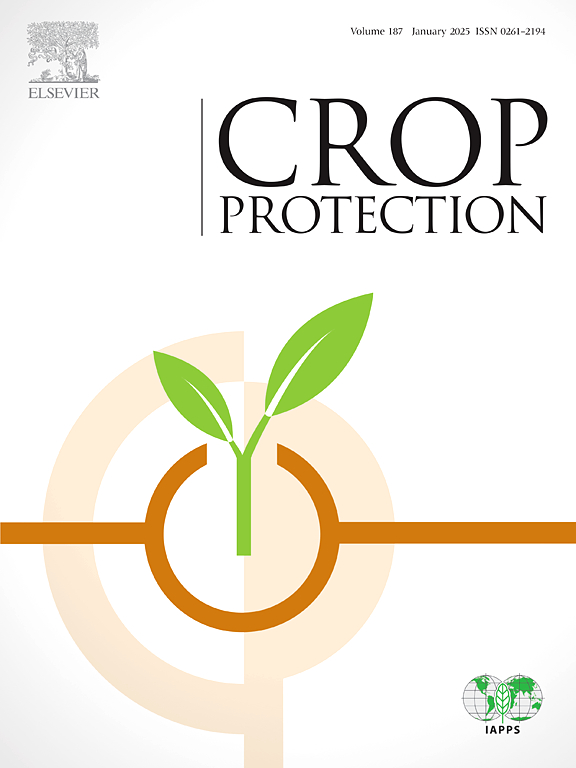Evaluation of foliar fungicides for Cercospora leaf spot management in table beet in New York
IF 2.5
2区 农林科学
Q1 AGRONOMY
引用次数: 0
Abstract
Cercospora leaf spot (CLS), caused by the fungus, Cercospora beticola, is a major constraint to table beet production in New York (NY). The disease causes defoliation, negatively impacting harvests using top-pulling machinery and rendering plants unsuitable for fresh market sales. High genetic diversity within C. beticola populations can result in the rapid development of resistance to single-site mode of action fungicides. Therefore, products with multiple modes of action and/or differential site-specific modes of action are highly desirable to improve the resiliency of CLS management. In 2021 and 2022, small plot replicated trials were conducted to evaluate the efficacy of selected fungicides for CLS management in table beet at Geneva, NY. Propiconazole, pydiflumetofen + fludioxonil, and copper hydroxide were the most efficacious for CLS management and not significantly different between each other. Across these treatments, CLS severity was reduced by 72.8% and 78.6% compared to nontreated plots in 2021 and 2022, respectively. Trifloxystrobin + fluopyram, pyrimethanil + fluopyram and pyraclostrobin + fluxapyroxad provided moderate disease control with an average reduction of 45.4% and 56.7% in CLS severity in 2021 and 2022, respectively. Trifloxystrobin and a proprietary copper + zinc (Cu/Zn) compound at two rates (0.25% and 0.5% v/v) also significantly reduced CLS severity by 20.1% in 2021 but not in 2022. Improvements in foliar health through reduced CLS severity had no significant effect on root shape, size, color, and sugar content. This information underpins best management practices for foliar health leading to economic and sustainable outcomes for table beet producers.
评估叶面杀真菌剂对纽约甜菜 Cercospora 叶斑病的防治效果
由真菌 Cercospora beticola 引起的 Cercospora 叶斑病(CLS)是纽约(NY)甜菜生产的主要制约因素。该病会导致落叶,对使用顶拔机械的收获造成负面影响,并使植株不适合在新鲜市场上销售。C. beticola(甜菜褐斑病)种群内的高度遗传多样性会导致对单点作用模式杀真菌剂抗性的快速发展。因此,具有多种作用模式和/或不同部位特异性作用模式的产品非常适合用于提高 CLS 管理的抗逆性。2021 年和 2022 年,在纽约州日内瓦市进行了小地块重复试验,以评估选定杀菌剂对甜菜 CLS 管理的功效。丙环唑、吡唑醚菌酯 + 氟啶虫酰胺和氢氧化铜对 CLS 的防治效果最好,且无显著差异。与 2021 年和 2022 年未处理的地块相比,这些处理的 CLS 严重程度分别降低了 72.8% 和 78.6%。三唑醇+氟吡甲禾灵、嘧菌酯+氟吡甲禾灵和吡唑醚菌酯+氟吡甲禾灵提供了中等程度的病害控制,2021 年和 2022 年 CLS 严重程度分别平均降低了 45.4% 和 56.7%。三氟苯菌唑和专有的铜+锌(Cu/Zn)复配制剂以两种比例(0.25% 和 0.5% v/v)使用,也能在 2021 年将 CLS 严重程度显著降低 20.1%,但在 2022 年则不能。通过降低 CLS 严重程度来改善叶面健康对根的形状、大小、颜色和含糖量没有显著影响。这些信息为叶面健康的最佳管理实践提供了依据,从而为甜菜生产者带来经济和可持续的成果。
本文章由计算机程序翻译,如有差异,请以英文原文为准。
求助全文
约1分钟内获得全文
求助全文
来源期刊

Crop Protection
农林科学-农艺学
CiteScore
6.10
自引率
3.60%
发文量
200
审稿时长
29 days
期刊介绍:
The Editors of Crop Protection especially welcome papers describing an interdisciplinary approach showing how different control strategies can be integrated into practical pest management programs, covering high and low input agricultural systems worldwide. Crop Protection particularly emphasizes the practical aspects of control in the field and for protected crops, and includes work which may lead in the near future to more effective control. The journal does not duplicate the many existing excellent biological science journals, which deal mainly with the more fundamental aspects of plant pathology, applied zoology and weed science. Crop Protection covers all practical aspects of pest, disease and weed control, including the following topics:
-Abiotic damage-
Agronomic control methods-
Assessment of pest and disease damage-
Molecular methods for the detection and assessment of pests and diseases-
Biological control-
Biorational pesticides-
Control of animal pests of world crops-
Control of diseases of crop plants caused by microorganisms-
Control of weeds and integrated management-
Economic considerations-
Effects of plant growth regulators-
Environmental benefits of reduced pesticide use-
Environmental effects of pesticides-
Epidemiology of pests and diseases in relation to control-
GM Crops, and genetic engineering applications-
Importance and control of postharvest crop losses-
Integrated control-
Interrelationships and compatibility among different control strategies-
Invasive species as they relate to implications for crop protection-
Pesticide application methods-
Pest management-
Phytobiomes for pest and disease control-
Resistance management-
Sampling and monitoring schemes for diseases, nematodes, pests and weeds.
 求助内容:
求助内容: 应助结果提醒方式:
应助结果提醒方式:


